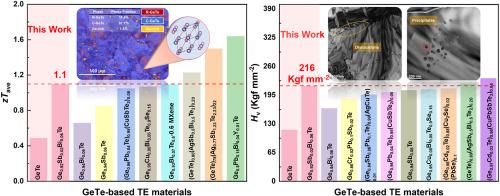对称导向晶体结构设计提高了菱形GeTe的平均zT和力学性能
IF 9.7
2区 材料科学
Q1 MATERIALS SCIENCE, MULTIDISCIPLINARY
引用次数: 0
摘要
GeTe作为一种特殊的热电材料,由于其多价带边和独特的相变而引起了人们的广泛关注。然而,实现电输运和热输运之间的权衡仍然是提高其TE性能的主要障碍。为了克服这一限制,我们提出调节晶格的菱形畸变。该方法保持了高对称性结构的高能带简并特性,同时受益于低对称性结构的热导率降低,从而提高了GeTe的TE性能和力学性能。具体来说,Sb和Bi的掺入调整了晶体结构的对称性,从而优化载流子浓度并驱动带收敛。此外,晶界、位错、平面空位和纳米沉淀物增强了多频声子散射。因此,Ge0.92Sb0.02Bi0.06Te在723 K时的zT最大值为~ 1.8,在323和723 K之间的平均zT (zTave)为~ 1.1,与原始GeTe相比,提高了124%。同时,Ge0.92Sb0.02Bi0.06Te的硬度和抗压强度分别提高到~ 216 Kgf mm-2和~ 175 MPa。这项工作阐明了对称驱动能带结构和多尺度缺陷在推进TE材料中的关键作用。本文章由计算机程序翻译,如有差异,请以英文原文为准。


Symmetry-guided crystal structure design enhances average zT and mechanical properties in rhombohedral GeTe
As a distinguished thermoelectric (TE) material, GeTe has attracted considerable focus owing to its multiple valence band edges and distinctive phase transition. However, achieving the tradeoff between electrical transport and thermal transport remains a major obstacle to improving its TE performance. To overcome this limitation, we propose regulating the rhombohedral distortion of the crystal lattice. The approach maintains the high band degeneracy characteristic of high-symmetry structures and concurrently benefits from the reduced thermal conductivity of low-symmetry structures, resulting in enhanced TE performance and mechanical properties in GeTe. Specifically, the incorporation of Sb and Bi tailors crystal structure symmetry, thereby optimizing carrier concentration and driving band convergence. Additionally, grain boundaries, dislocations, planar vacancies, and nanoprecipitates enhance multi-frequency phonon scattering. Consequently, Ge0.92Sb0.02Bi0.06Te achieves a maximum zT of ∼1.8 at 723 K, and an excellent average zT (zTave) of ∼1.1 between 323 and 723 K, representing an impressive 124 % enhancement compared to pristine GeTe. Meanwhile, the hardness and compressive strength of Ge0.92Sb0.02Bi0.06Te are enhanced to ∼216 Kgf mm−2 and ∼175 MPa, respectively. This work illuminates the pivotal role of symmetry-driven band structure and multi-scale defects in advancing TE materials.
求助全文
通过发布文献求助,成功后即可免费获取论文全文。
去求助
来源期刊

Materials Today Physics
Materials Science-General Materials Science
CiteScore
14.00
自引率
7.80%
发文量
284
审稿时长
15 days
期刊介绍:
Materials Today Physics is a multi-disciplinary journal focused on the physics of materials, encompassing both the physical properties and materials synthesis. Operating at the interface of physics and materials science, this journal covers one of the largest and most dynamic fields within physical science. The forefront research in materials physics is driving advancements in new materials, uncovering new physics, and fostering novel applications at an unprecedented pace.
 求助内容:
求助内容: 应助结果提醒方式:
应助结果提醒方式:


